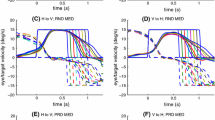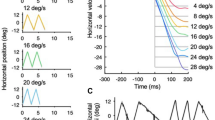Abstract
The smooth-pursuit system interacts with the vestibular system to maintain the image of a moving target on the fovea. Efficient tracking performance requires information about the velocity and the initiation of target motion. Previous studies in monkeys have shown that training with orthogonal pursuit and whole body rotation results in adapted eye movement direction during chair rotation. In addition, the latency of the pursuit shortens and initial eye velocity increases in a task-dependent manner. To examine whether these adapted eye movements are predictive pursuit, we studied whether our monkeys could predict the timing of smooth eye movement initiation during chair rotation. Two young Japanese monkeys were rotated horizontally in a trapezoidal waveform (20°/s, ±10°) with random inter-trial intervals. A laser spot was moved vertically with the same trajectory at a constant delay ranging from 100 to 700 ms after the onset of the chair motion. The monkeys were required to pursue the spot. After this training, the latencies of pursuit eye movements following the onset of chair motion were examined in the presence of the target motion. The target was also briefly (for 500–700 ms) extinguished at 80 ms after the onset of chair rotation. Pursuit eye movements after training were initiated before the onset of target motion and the latencies were proportional to the delays used for training. The latencies and response magnitudes of pursuit with or without target blanking were similar. The auditory–pursuit training did not induce an initial pursuit response similar to that induced by vestibular–pursuit training. These results indicate that smooth eye movements during the chair rotation after the vestibular–pursuit training included a predictive pursuit component. The monkeys’ estimate of the delays revealed by the latencies of pursuit was shorter by 22–36% than the actual delays.






Similar content being viewed by others
References
Akao T, Kurkin S, Fukushima K (2004) Latency of adaptive vergence eye movements induced by vergence–vestibular interaction training in monkeys. Exp Brain Res 158:129–132
Barnes G (1993) Visual-vestibular interaction in the control of head and eye movement: the role of visual feedback and predictive mechanisms. Prog Neurobiol 41:435–472
Barnes GR, Asselman PT (1991) The mechanism of prediction in human smooth pursuit eye movements. J Physiol 439:439–461
Barnes GR, Donelan SF (1999) The remembered pursuit task: evidence for segregation of timing and velocity storage in predictive oculomotor control. Exp Brain Res 129:57–67
Chakraborti SR, Barnes GR, Collins CJS (2002) Factors affecting the longevity of a short-term velocity store for predictive oculomotor tracking. Exp Brain Res 144:152–158
Ebata S, Sugiuchi Y, Izawa Y, Shinomiya K, Shinoda Y (2004) Vestibular projection to the periarcuate cortex in the monkey. Neurosci Res 49:55–68
Fuchs AF, Robinson DA (1966) A method for measuring horizontal and vertical eye movements chronically in the monkey. J Appl Physiol 21:1068–1070
Fukushima K (2003) Roles of the cerebellum in pursuit–vestibular interactions. Cerebellum 2:223–232
Fukushima K, Fukushima J, Chin S, Tsunekawa H, Kaneko CRS (1996) Cross-axis vestibulo-ocular reflex induced by pursuit training in alert monkeys. Neurosci Res 25:255–265
Fukushima K, Sato T, Fukushima J, Shinmei Y, Kaneko CR (2000a) Activity of smooth pursuit-related neurons in the monkey periarcuate cortex during pursuit and passive whole-body rotation. J Neurophysiol 83:563–587
Fukushima K, Sato T, Fukushima J, Kurkin S (2000b) Cross-axis VOR induced by pursuit training in monkeys: further properties of adaptive responses. Arch Ital Biol 138:49–61
Fukushima K, Wells SG, Takeichi N, Yamanobe T, Fukushima J (2001a) Adaptive changes in smooth pursuit eye movement induced by pursuit–vestibular interaction training in monkeys. Exp Brain Res 139:473–481
Fukushima K, Fukushima J, Yamanobe T, Shinmei Y, Kurkin S (2001b) Adaptive eye movements induced by cross-axis pursuit–vestibular interactions in trained monkeys. Acta Oto-laryngologica Suppl 545:73–79
Fukushima K, Yamanobe T, Shinmei Y, Fukushima J (2002) Predictive responses of peri-arcuate pursuit neurons to visual target motion. Exp Brain Res 145:104–120
Fukushima J, Akao T, Takeichi N, Kurkin S, Kaneko CR, Fukushima K (2004) Pursuit-related neurons in the supplementary eye fields: discharge during pursuit and passive whole body rotation. J Neurophysiol 91:2809–2825
Fukushima K, Akao T, Kurkin S, Fukushima J (2005) Role of vestibular signals in the caudal part of the frontal eye fields in pursuit eye movements in three-dimensional space. Ann NY Acad Sci 1039:272–282
Guide for the care and use of laboratory animals. Compiled by The National Research Council, Washington, DC, National Academy, 1997
Heinen SJ, Liu M (1997) Single-neuron activity in the dorsomedial frontal cortex during smooth-pursuit eye movements to predictable target motion. Visual Neurosci 14:853–865
Jarrett CB, Barnes G (2001) Volitional selection of direction in the generation of anticipatory ocular smooth pursuit in humans. Neurosci Lett 312:25–28
Leigh RJ, Zee DS (1999) The neurology of eye movements, 3rd edn. Oxford University Press, New York, pp 4–197
Lekwuwa GU, Barnes GR (1996) Cerebral control of eye movements. II. Timing of anticipatory eye movements, predictive pursuit and phase errors in focal cerebral lesions. Brain 119:491–505
McAvoy MG, Gottlieb JP, Bruce CJ (1991) Smooth pursuit eye movement representation in the primate frontal eye field. Cereb Cortex 1:95–102
Morrow MJ, Lamb NL (1996) Effects of fixation target timing on smooth–pursuit initiation. Exp Brain Res 111:262–270
Robinson DA (1981) Control of eye movements. In: Brookhart JM, Mountcastle JM (eds) Handbook of physiology vol 2 part 2. American Physiological Society, Bethesda, pp 1275–1320
Sato T, Yokoyama R, Fukushima J, Fukushima K (1999) Latency of cross-axis vestibulo-ocular reflex induced by pursuit training in monkeys. Neurosci Res 33:65–70
Sato F, Akao T, Kurkin S, Fukushima J, Fukushima K (2004) Adaptive changes in vergence eye movements induced by vergence–vestibular interaction training in monkeys. Exp Brain Res 156:164–173
Tsubuku T, Akao T, Kurkin S, Fukushima K (2004) Predictive smooth pursuit eye movement induced by vestibular input. Jpn J Physiol 154(Suppl):S181 (Abstract)
Walker MF, Zee DS (2002) Rectified cross-axis adaptation of the vestibulo-ocular reflex in rhesus monkey. Ann NY Acad Sci 956:543–545
Wells SG, Barnes GR (1998) Fast, anticipatory smooth-pursuit eye movements appear to depend on a short-term store. Exp Brain Res 120:129–133
Acknowledgments
We thank Dr. C.R.S. Kaneko for his valuable comments on this article. This research was supported by the grants from the Japanese Ministry of Education, Culture, Science, Sports and Technology (16650087,16300128, 16015203), Marna Cosmetics and Toyota Riken.
Author information
Authors and Affiliations
Corresponding author
Rights and permissions
About this article
Cite this article
Tsubuku, T., Akao, T., Kurkin, S.A. et al. Prediction in the timing of pursuit eye movement initiation revealed by cross-axis vestibular–pursuit training in monkeys. Exp Brain Res 168, 427–435 (2006). https://doi.org/10.1007/s00221-005-0102-2
Received:
Accepted:
Published:
Issue Date:
DOI: https://doi.org/10.1007/s00221-005-0102-2




